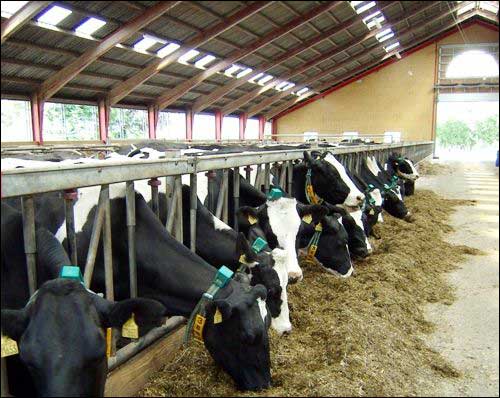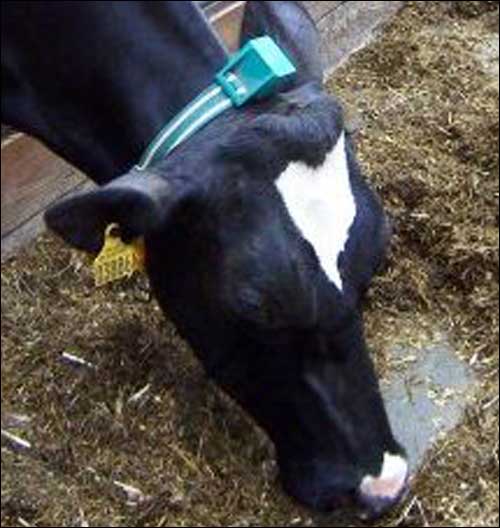Dairy farmers in Denmark are finding that an RFID-based real-time location system (RTLS) can help pinpoint individual animals within large herds, while also enabling them to analyze the cows’ movements in order to predict which individuals exhibit signs of illness. Diagnosing and treating a disease early in its progression translates into improved farm production, and also decreases the chances that an animal will have to be slaughtered due to that illness.
Farmers are also using the technology to look for signs—based on movement and eating patterns—that individual cows are entering into heat and will soon ovulate. With this information, they can schedule the animals for insemination, which is more likely to lead to a successful pregnancy than performing the procedure based on a calendar cycle. By improving the likelihood of achieving a successful fertilization, a farmer can keep the cow producing offspring consistently, thus increasing the profit he is able to derive from that animal.
The technology, developed by Danish firm SmarterFarming, employs active, ultra-wideband (UWB) RFID tags and interrogators manufactured by Ubisense. The tags emit a series of short signals (billionths of a second or shorter) at frequencies between 6 and 8 GHz. According to Ubisense, the extremely short nature of these pulses makes them less vulnerable to RF interference from objects and other RF noise, relative to conventional RFID-based RTLS technologies. Once a reader receives a tag’s signal by means of a phased-array antenna, it calculates that tag’s location by employing two complementary techniques: time difference of arrival (TDOA) and angle of arrival (AOA).
Keld Florczak, SmarterFarming’s CEO, developed the animal-tracking and -monitoring system, known as CowDetect, after meeting with Aage Hindhede, a 10th-generation dairy farmer with a 130-head herd of milking cows, in Ringkøbing-Skjern, Denmark. Hindhede recognized that he, like other farmers in that country (particularly those with much larger herds), wanted a means of ensuring that each individual cow is milked multiple times daily, and of improving overall herd management.
Hindhede, now a stakeholder in the CowDetect system and Florczak’s firm, is also utilizing the technology to watch for illness among his herd of 130 milking cows and 130 calves, as well as for detecting which adults are in heat. In the year since he began using CowDetect, he reports he has had more successful cow inseminations and is better able to prevent animals from becoming severely ill than in the past, when he relied only on visual inspection of the animals.
Three other Danish dairy farms have deployed CowDetect this year, the largest of those raising up to 600 cows at any given time. These operations employ robotic, automated milking machines, which the cows learn, over time, to visit multiple times each day, when a special feed is dispensed. RFID interrogators mounted over the robotic milking machines read a passive ISO-compliant 134.2 kHz RFID tag attached to each animal’s ear, thereby verifying that cow has been milked. If the information collected by these readers indicates that a specific cow is not getting sufficiently milked, a farmer needs to find that animal and bring her to a milking machine. Before deploying the Ubisense RTLS, these farmers might have spent hours trying to locate the individual cows that were not being regularly milked. With CowDetect, the farmers know immediately where those animals can be found.
To develop CowDetect’s animal behavior analysis element, Florczak and Hindhede worked with animal health and behavior specialists from the Institute for Agri Technology and Food Innovation (AgroTech), part of the Danish government’s ministry of science. These experts developed a list of 14 indicators—such as the frequency of visiting a feeding station, or the speed and direction of travel—that would serve as the basis for the behavioral analysis. For instance, up to 3.5 days prior to developing ketosis (a common disease in adult cattle), cows spend less time eating. Animals suffering from ketosis may also have an abnormal gait and show other symptoms as well, such as aggression or bellowing. Ketosis is common among dairy cows bred and managed for high production.
Detecting ketosis early in its onset is key for dairy farmers, Hindhede explains, because if left untreated, the disease will cause a cow to cease lactating. Once that happens, the farmer will need to have the animal slaughtered because it will no longer be profitable to keep it alive. Farmers generally realize that a cow has the disease after noticing changes in its stool and eating pattern, but Hindhede and Florczak contend that using the CowDetect system to analyze each animal’s eating and movement patterns can result in a diagnosis up to a week sooner than was possible without the technology. A cow with ketosis, Hindhede says, may stop lactating within 14 days if left untreated.
Florczak developed a set of algorithms that use combinations of the indicators to create alerts in the CowDetect software. Farmers can employ these alerts to locate and inspect a particular animal for sickness, or to schedule an insemination if the indicators suggest an impending ovulation.
While the Ubisense tags and software can quickly locate individual animals to within roughly 15 centimeters (5.9 inches), Florczak says this is not sufficiently precise to carry out some of the measurements required to detect certain body positions or subtle movements that animal specialists say are important to monitor. So in order to provide more precise measurements, Florczak combined the Ubisense tags with a secondary non-RFID technology (he declines to provide additional details since his patent on the combined technologies is still pending). The two devices, along with a battery that powers them both (thereby providing supplemental power to the integrated battery in the Ubisense tag), are placed in a rugged housing that attaches to a collar surrounding each cow’s neck.
According to Florczak, for a farm with 200 cows—and, therefore, demand for 200 of the customized Ubisense tag modules—the per-animal cost of the CowDetect system is €360 ($511). This expense covers all necessary hardware and software, but does not include installation labor costs. The CowDetect system is available globally through SmarterFarming, wherever the Ubisense system is sold—including throughout Europe, North America and some parts of Asia.
Based on what it has observed on the farms using CowDetect to track and monitor lactating cows, AgroTech estimates that farmers can save between €315 and €355 ($448 and $505) annually, per animal, based on lower labor costs and higher herd productivity.
In the United States, a company called TekVet launched a similar solution for tracking beef cattle in 2006 (see TekVet-IBM Cattle Tracker Uses Active RFID Tags, Satellite Communication). The system includes active 418 MHz RFID tags with a temperature sensor that fit inside an animal’s ear canal, adjacent to the tympanic membrane. Once every hour, the tag transmits its unique ID number and the animal’s temperature to RFID readers attached to poles, or to walls of buildings on a cattle producer’s lot. TekVet claims its health-monitoring system can immediately identify a rise in temperature associated with many common illnesses, thereby allowing the livestock producer to provide early treatment, and thus improve the prospects for recovery.



